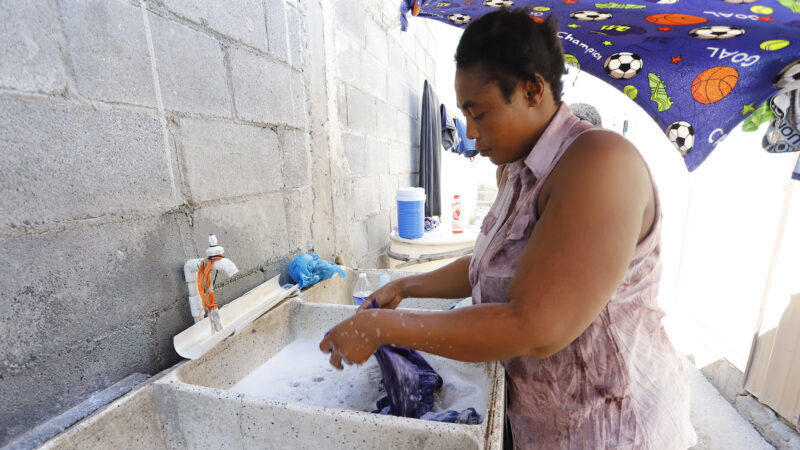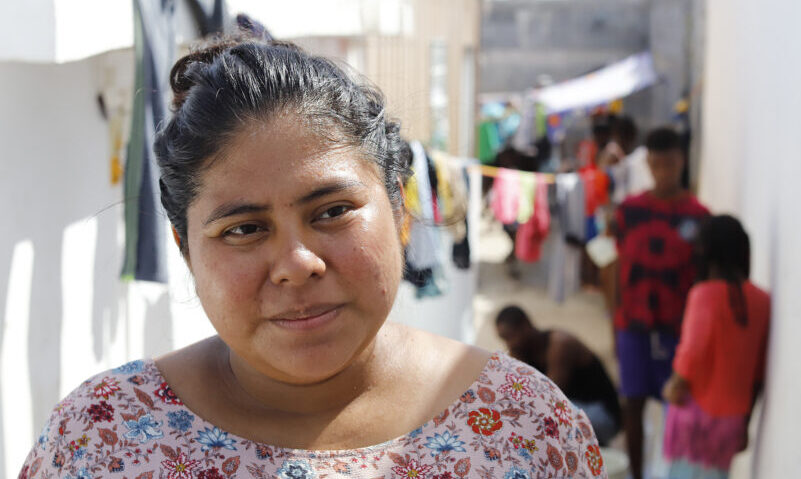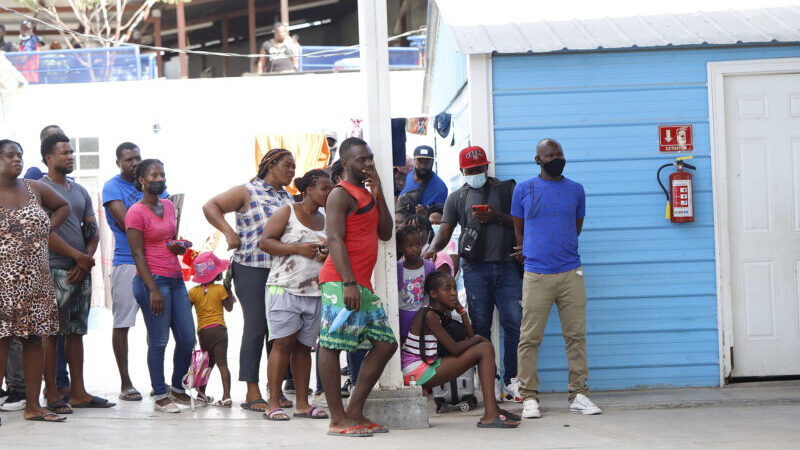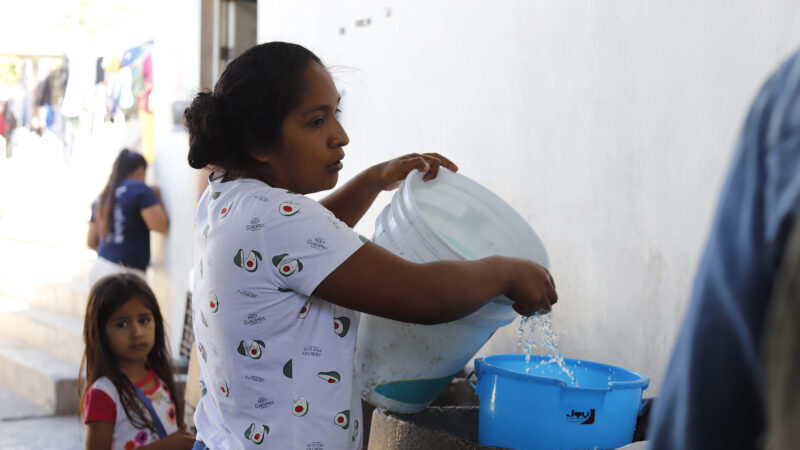“Clean water is so important for us being pregnant, because we need to go to the toilet constantly. And with this heat we get thirsty and need to refresh ourselves more often,” says Sandra Cantor, a 26-year-old migrant from El Salvador in her eighth month of pregnancy. “This is a very hot zone and water is very needed to have regular showers.”
Cantor has spent at least three months of her pregnancy with her husband in the migrant shelter Senda de Vida I, in Reynosa, Tamaulipas, located less than a kilometre from the Rio Grande, which marks the legal border between Mexico and the USA. Reynosa has become a waiting station for thousands of migrants who look for a chance to cross into the USA to start an asylum process.
The wait in Reynosa can be exhausting in the summer, when temperatures in the manufacturing city often reach 42C. This year Reynosa has been unusually dry, according to the national drought monitor, which puts extra pressure on everyone passing through the dusty landscape. Drought this year was either moderate or extreme for 1546 of the 2463 municipalities in Mexico, according to the National Water Commission. This means that people throughout the country have to wait longer for water or pay more to access enough to cover their basic needs.
If the situation seems desperate for Mexicans, it is a nightmare for the almost 10,000 migrants waiting in Reynosa for a chance to cross into the US. More than half of the migrant population lives outside shelters, without access to clean or drinkable water. This results in poor hygiene and water-borne diseases, particularly among children.
Cantor is not the only pregnant woman waiting at the shelter in Reynosa. There are at least 400 women in the same situation, according to shelter managers. There are around 800 children in the shelter, many of them newborns and toddlers who are more susceptible to water-borne diseases that range from skin rashes to chronic diarrhoea, according to the organisation Global Response Management (GRM), which provides healthcare in the shelters.

Water for washing clothes and showering is restricted at the migrant shelters in Reynosa, northern Mexico (All photos: Ali Quiroga)
The latest wave of Covid-19, which has been sweeping Mexico since early June, presents another major health risk.
“When there is not enough water to drink, handwashing comes second,” says Brendan Tucker, project coordinator for GRM.
Some migrants, like Sherley Donaivil from Haiti, have learned to save a 5-litre jug of water as a personal ration for critical hygiene. But for families, the water scarcity presents a daily financial struggle.
“I have a two-year old girl, and when there is no water I have to buy at least 5 bottles that cost me more than 200 Pesos ($10) – the kind of money that we are not earning here,” says Rood Stanley, a 31-year-old father from Haiti. “If there is not enough water we stop taking showers and washing our clothes, but the first [priority] is having water for the kid.”
Rood says that on his long journey from Port-au-Prince, he did not experience drought and water scarcity as severe as in Reynosa.
#mc_embed_signup{background:#fff; clear:left; font:14px Helvetica,Arial,sans-serif; }
/* Add your own Mailchimp form style overrides in your site stylesheet or in this style block.
We recommend moving this block and the preceding CSS link to the HEAD of your HTML file. */
Despite the drought, water supply is mostly secured for the 4,000 migrants hosted in the two Senda de Vida shelters, located less than one kilometre apart in the same border strip overlooking the Rio Grande. But the story is very different for the population waiting in tents outside the shelter walls, where the local faith-based groups struggle to provide basic services.
Pastor Hector Silva had been supporting migrants in the area since he founded Senda de Vida more than 25 years ago. Currently he oversees as the shelter as director. In all these years, Silva has never experienced such a large population of migrants and such severe water scarcity.
“We didn’t know that for this time we were going to need so much water, but water authorities in the city can’t give us [any] more because it would then lack in other neighbourhoods,” says Silva.
Over 90% of the migrants in Senda de Vida come from Haiti, says Silva. The rest are from Honduras, Nicaragua, El Salvador and Mexico. Their reasons for migrating are varied: migrants travelling from Haiti are escaping political turmoil and economic instability back home, while others are fleeing the devastation caused by hurricanes Eta and Iota across central America in November 2020. In recent months, some families from Russia and Ukraine also joined the shelter.

Sandra Cantor (pictured) is 8 months pregnant. There are 400 pregnant women living in the Reynosa shelters without regular access to water
Although migration has always been an issue in Reynosa, the Remain in Mexico policy implemented by the Trump administration in early 2019 has transformed the face of the city by keeping thousands of migrants stuck there.
The situation worsened during the coronavirus pandemic, when Trump invoked Title 42 to prevent migrants from crossing the border on the basis of contagion risk.
“All these policies tend to lead to high numbers in concentrations of very vulnerable people in specific border locations that may be far from the locations that are best equipped to deal with a large influx of people,” says Stephanie Brewer, director for Mexico and migrant rights at the Washington Office on Latin America (WOLA). “This is not a well-designed, rational, migration management strategy. So it’s an alarming time and the human impact of Title 42 is indisputable.”
Neither the US or Mexican government is directly involved in the situation with shelters such as those in as Reynosa.
The National Migration Institute of Mexico claimed last May that it was protecting the human rights of migrants by moving a camp from a public square to Senda de Vida, which INM provided with sleeping mats. Most humanitarian work is carried out by local NGOs, mainly faith-based groups and grassroot organisations.
While Pastor Silva oversees the general operation of Senda de Vida, water and sanitation is handled by a women-led group of engineers called Solidarity Engineering. Healthcare is provided by Global Response Management and Doctors Without Borders, while some services for children are facilitated by Save the Children, UNHCR and Unicef.
“Everybody is running at full capacity here”, says Brendon Tucker, from GRM, during a break in his day shift where he and his team will see 60 patients. They often treat up to 90 patients a day. “I’ve been here for four years and I remember when [there were] 15 people [in the shelter]. Four years later there are more than 10,000. We all collectively need as much help as we can get,” says Tucker.

Migrants living in Reynosa, Mexico, wait for the weekly water delivery truck
Pastor Silva lives in Senda de Vida, where he works long days, overseeing everything from the water supply to the paperwork of migrants accepted by the Customs and Border Protection Agency to enter the US. In most of the tasks he is assisted by a group of migrants.
Erin Hughes, co-founder and principal engineer at Solidarity Engineering, rushes on a Monday morning to meet the truck delivering drinking water to one of the shelters. “We take shifts with Doctors without Borders and the pastor to pay for the water, and this week it is up to us,” she explains. Every month, between $4,000 and $6,000 are paid to fill the tanks for drinking water. All Solidarity Engineering’s funds come from small-scale, private donors. “We stretch every dollar, but it’s never enough, says Hughes.
The shelter Senda de Vida II opened in May 2022, in order to receive the population from a camp dissolved in Plaza de la República, in downtown Reynosa, where they spent most of the pandemic. Rushed by politics, the shelter was not finished and it still lacks crucial services, like shade zones and a functioning sewage network.
“We want to install a grey water system to reuse water from the laundry posts into the toilets, but we have limited resources and we do what we can with what we have,” says Hughes, whose team have already installed storing tanks, washing points and toilets as part of the sanitary infrastructure. Sanitation is as important as clean water, because dirty water can become a source of illness. But water is crucial to lower the temperature under the scorching sun, making the laundry points a popular play area for children.
Activists are up against the clock. In Senda II, which hasn’t even been open for six months, the septic tank is already full and has begun to leak. If not controlled rapidly, it can filter to the water table, causing problems with the neighbours, explains Chloe Rastatter, field engineer for Solidarity Engineering.
The urgency to address these issues is not matched by the funds available to these NGOs. “We even lost some donors that divested their donations to Ukraine when the war started, but this crisis here is still ongoing, although it has become invisible,” says Rastatter.
Policing water
In Senda II, all the water taps in the tanks for drinkable water have a padlock to avoid people from wasting precious water. People can drink as much as they want and even fill personal bottles, but not store large quantities for washing or showering. It did not use to be like this, but water scarcity has really taken a toll on people’s trust, says Johnny Arturo Gómez, from Honduras, who informally polices the water tanks to discard water misuse.
“It’s a shame, but it has to be like this, because it’s a resource meant for everybody and it has to last,” says Gómez.

Every drop of clean water is policed in the shelters in Reynosa, northern Mexico, to prevent it from running out
Not only drinking water is policed, but also every drop of clean water. The shower rooms in Senda II are open just three hours in the morning and three in the evening, and locked at all other times. At the laundry points, women take advantage of every minute of running water to wash their families’ clothes, because they don’t know when they will next be able to do it.
Brewer says this water stress adds to the list of hardships that migrants have to go through in their pursuits of the American Dream. That list includes being harassed by criminals, abused by different authorities or suffering discrimination.
“This highlights that regardless of the situation that led you to migrate, climate change and disasters are also going to play an increasing role as one of the main hardships migrants are facing on their path, during their transit and in the places where they are staying,” says Brewer.
In the case of the Senda de Vida shelters, many migrants were forced to leave their homes due to climate-related events, says Brendan Tucker, from GMR.
“A lot of people here are climate refugees,” says Tucker. “We have people that fled Honduras and Guatemala after the climate change-fueled hurricanes that hit there, and we can only expect more of those issues to happen. This is not going away anytime soon. This is the future of migration.”
The World Bank estimates that climate change could force up to 216 million people to leave their homes and become internal climate migrants by 2050.
A steady flow of permits to cross into the USA gives people in Senda de Vida reason to stay, despite the scorching heat and water scarcity.
“This lack of water is awful, mostly because we are here out of need, and going through this kind of situation only makes it worse,” says Cantor. “At the end we are here to be helped, that is why we are going after the American Dream.”
Main image: Water for handwashing and showering is severely restricted in the migrant shelters Senda de Vida in Reynosa, northern Mexico. Credit: Ali Quiroga.
This article is part of a climate justice reporting programme supported by the Climate Justice Resilience Fund.